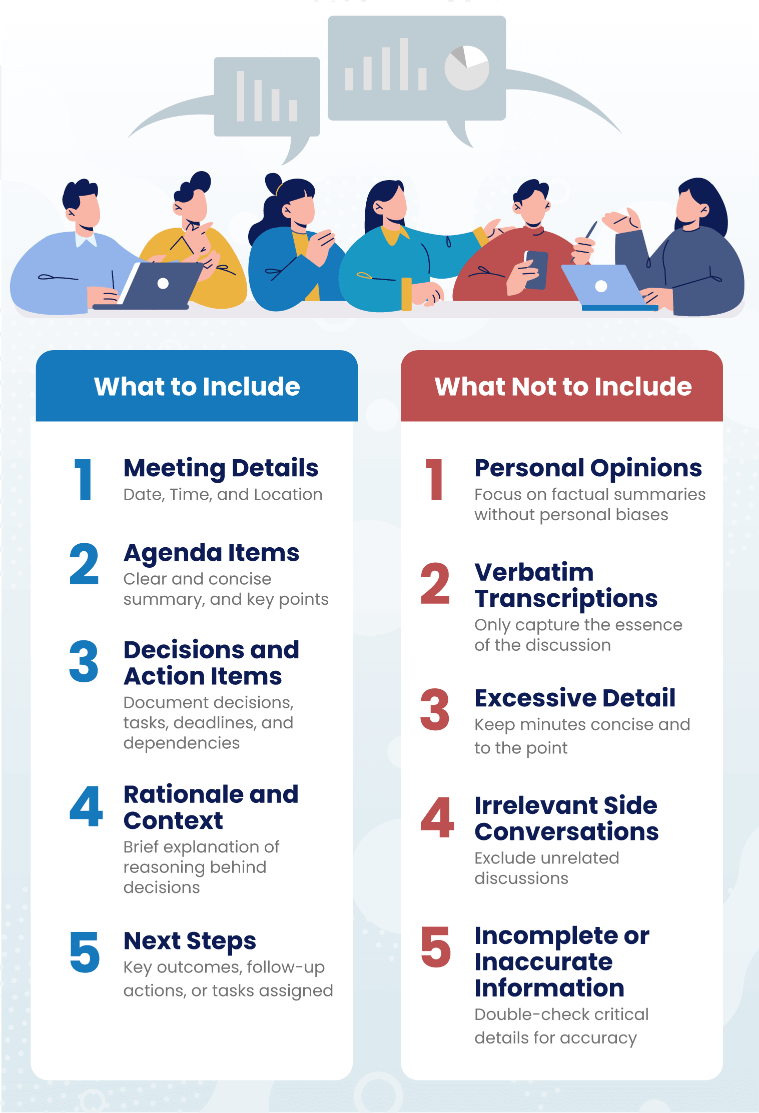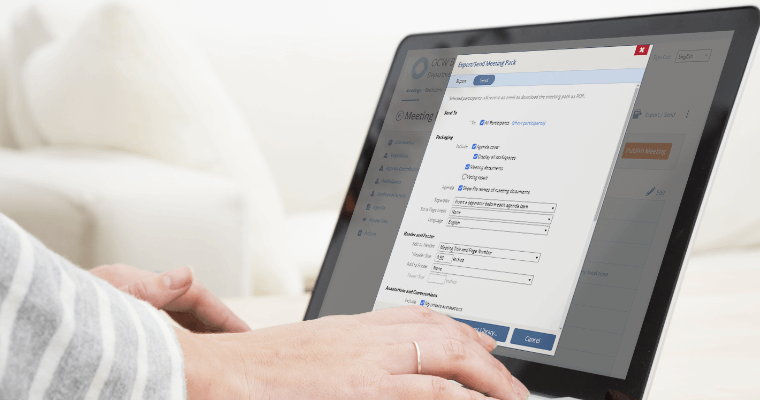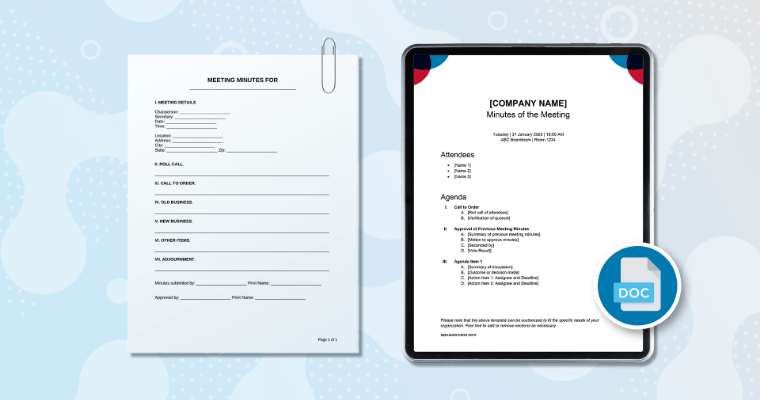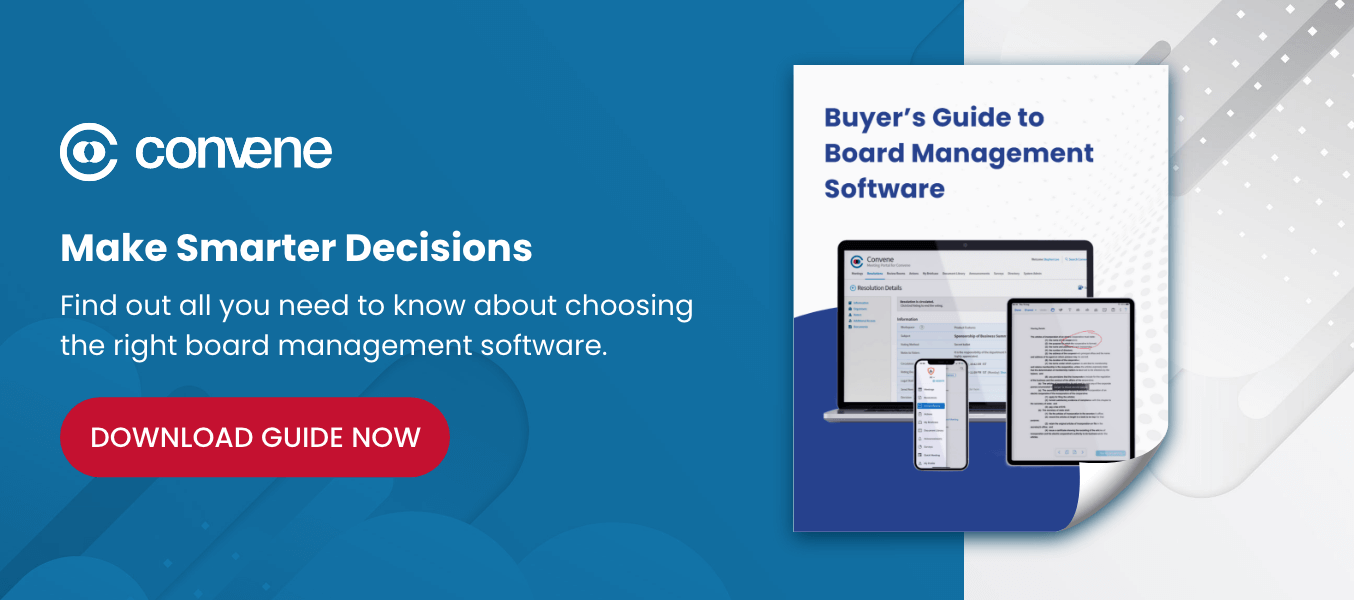Taking minutes at a meeting is a crucial task for effective communication and decision-making within organizations. But it is not just above writing down everything being discussed. Effective minutes focus on the critical points of the meeting, and they should have structure and clarity.
In this guide, we will dive deep into what meeting minutes are, why they are important, and how to take minutes in a meeting. Plus, download a free meeting minutes template to streamline the process!
The Basics of Meeting Minutes
What are meeting minutes?
Meeting minutes are written records that capture the key discussions, decisions, and action items during a meeting. They serve as a reference for participants and absentees, providing a summary of what was discussed, agreed upon, and assigned during the meeting. Minutes often include details such as the meeting date, time, location, attendee names, and an overview of the agenda items.
Why are meeting minutes important?
The meeting minutes’ purpose is to help promote transparency and accountability within an organization. They serve as an official record of the meeting’s proceedings, documenting decisions, action items, and responsibilities. Minutes help participants stay informed, remind them of their commitments, and provide a historical reference for future meetings. They also serve as evidence of compliance with regulations and organizational requirements.
What’s the role of a minute taker?
The minute taker holds the responsibility of accurately recording the discussions and outcomes of a meeting. Their role is to actively listen, observe, and capture the main points, decisions, and action items in a clear and concise manner. The minute taker should remain unbiased and objective, focusing on factual information rather than personal opinions. Attention to detail, strong organizational skills, and the ability to synthesize information are essential for an effective minute taker.
Quick Tips for Effective Minute-Taking

Taking minutes at a meeting is crucial for capturing and documenting the important details of a meeting. This tip sheet provides guidance on what to include and not to include, ensuring accurate and valuable records.
What to Include
- Meeting Details — These include the date, time, and location of the meeting, names and roles of attendees, and any relevant background information or context.
- Agenda Items — This should be a clear and concise summary of each agenda item discussed. Also, include key points, ideas, and arguments raised during the discussion.
- Decisions and Action Items — Document decisions made during the meeting. Outline action items such as tasks, responsible individuals, and deadlines. Don’t forget to also specify any dependencies or follow-up required.
- Rationale and Context — Provide a brief explanation of the reasoning behind decisions. Be sure to include important contextual information that influenced discussions.
- Next Steps — Summarize the key outcomes of the meeting, and outline any follow-up actions, or tasks assigned.
What Not to Include
- Personal Opinions — Avoid including personal opinions or biases in the meeting minutes. Focus on factual information and objective summaries of discussions.
- Verbatim Transcriptions — It is not necessary to record every word spoken during the meeting. Instead, capture the essence of the discussions and important points.
- Excessive Detail — Keep the minutes concise and to the point. Avoid unnecessary details that do not contribute to the understanding of the meeting.
- Irrelevant Side Conversations — Exclude unrelated conversations or discussions that are not directly related to the agenda items.
- Incomplete or Inaccurate Information — Ensure that the minutes accurately reflect the discussions and decisions made. Double-check names, action items, and other critical details for accuracy.
By following these tips, you can enhance your minute-taking skills and create valuable meeting records. Effective minutes contribute to transparent communication and successful outcomes within your organization.
How to Take Minutes in a Meeting: 7 Easy Steps
Taking minutes at a meeting requires the right techniques and a systematic approach. In this section, we’ve outlined a series of steps to guide you through the process.
- Prepare — Before the meeting, gather all relevant materials, such as the agenda, previous meeting minutes, and any supporting documents. Familiarize yourself with the meeting’s purpose, topics, and attendees.
- Record basic information — At the beginning of the minutes, be sure to include the meeting date, time, location, attendees’ names, and any absentees. Don’t forget to also write the name of the minute taker.
- Capture the agenda — Write down the meeting agenda or use a template to structure your notes. Create headings or sections for each agenda item to keep the minutes organized.
- Summarize discussions and decisions — During the meeting, actively listen and take notes on the key points discussed. Use concise and clear language, and avoid personal opinions or irrelevant details. If clarification is needed, don’t hesitate to ask for it during the meeting. Relying on memory alone may lead to misinformation.
- Document action items — Record the assigned tasks or action items discussed during the meeting. Include the assignee’s name, the task description, and the deadline or due date. This ensures accountability and allows for easy tracking of progress.
- Review and proofread — After the meeting, review your minutes for accuracy, clarity, and completeness. It should be a faithful representation of what transpired during the meeting. Check for any typos or errors and make necessary corrections.
- Distribute and archive — Once finalized, distribute the minutes to the attendees. Share it promptly while the discussions are fresh in everyone’s minds, which, after all, is the meeting minutes’ purpose. Save a copy in a centralized location, such as a shared drive or project management tool, for future reference.
Remember, meeting minutes should be objective, factual, and concise. They serve as a formal record of the meeting and should capture the most critical information without unnecessary details.
Streamline your board meeting documentation with our customizable meeting minutes template. Click below to download and simplify your minute-taking process today!
Download Meeting Minutes Template

Frequently Asked Questions About Taking Meeting Minutes
In this section, we address common questions related to taking minutes at a meeting. Whether you’re a seasoned minute taker or new to the role, this FAQ section will help you navigate the challenges of capturing effective meeting minutes.
1. How long should the meeting minutes be?
Meeting minutes should be concise and focused. While the length may vary depending on the meeting’s complexity, only capture the key points without including unnecessary details. Aim for a comprehensive summary that remains easily digestible.
2. How soon should meeting minutes be distributed?
Meeting minutes should be distributed promptly after the meeting, ideally within 24 to 48 hours. Timely distribution ensures that participants have a fresh understanding of discussions, decisions, and action items.
3. Should I include personal opinions?
No, meeting minutes should remain impartial and objective. Avoid including personal opinions or subjective statements. Stick to factual information, decisions made, and action items assigned. The meeting minutes’ purpose is to provide an accurate and neutral record of the meeting.
4. How can I ensure the confidentiality of the minutes?
To ensure confidentiality and security, use secure file-sharing platforms or encrypted email to distribute meeting minutes. Be mindful of sharing minutes only with authorized individuals and consider implementing access controls. Safeguarding sensitive information is crucial to maintain privacy and protect organizational data.
5. Should I document every discussion point?
While capturing the main discussion points is important, avoid documenting every detail. Summarize key ideas, decisions, and action items. Prioritize clarity and coherence to provide an accurate overview without overwhelming readers.
6. How long should I retain meeting minutes?
Retention periods vary based on legal and organizational requirements. Generally, it is recommended to keep meeting minutes for one to three years. Consult your organization’s policies or legal guidelines for the appropriate duration.
7. How can I improve my minute-taking skills?
Enhance minute-taking skills by actively listening, practicing effective note-taking techniques, and developing real-time information synthesis. Regularly review and analyze your minutes for accuracy and clarity. Seek feedback and training opportunities for continuous improvement.
How Convene Can Help You in Taking Minutes

Effective meeting minutes could be a strategic tool for improving decisions in organizations. Convene, a modern board meeting app, offers valuable assistance in taking minutes — easier and more accurate.
Convene’s Meeting Minutes Workflow makes the entire process seamless, from the minute-taking, approval, to the distribution. Minute-takers can effortlessly record discussions and decisions during live meetings using the Minute Taker Tool. To make the task less daunting, users can quickly generate draft minutes using the customizable template.
Discover how Convene can help you take effective minutes. Book a demo now!
Jielynne is a Content Marketing Writer at Convene. With over six years of professional writing experience, she has worked with several SEO and digital marketing agencies, both local and international. She strives in crafting clear marketing copies and creative content for various platforms of Convene, such as the website and social media. Jielynne displays a decided lack of knowledge about football and calculus, but proudly aces in literary arts and corporate governance.












